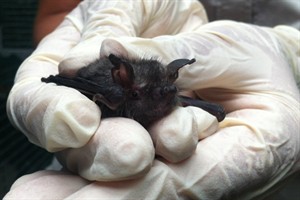Successful breeding of threatened bats at Auckland Zoo
 Source: Auckland Zoo.
Source: Auckland Zoo.
Auckland Zoo is celebrating successfully breeding and rearing lesser short-tailed bat twins – the first time this threatened endemic New Zealand species has ever been bred and hand-reared in a zoo.
The tiny short-tailed bats (pekapeka), a male and a female, born in mid-November weighing just 4 grams (weight of a 20 cent coin!), are now a healthy adult weight of around 14 grams.
New Zealand Centre for Conservation Medicine (NZCCM) Clinical services coordinator Mikaylie Wilson says that, “while very rare to produce twins (one pup is usual) their mother had given birth to twins earlier but they did not survive. From this experience, we knew she wasn’t able to cope with raising two, so the decision was made to pull the first twin at two days, and then at two weeks, the second pup was failing to thrive so we pulled it as well.”
Mikaylie, who has experience hand-rearing bats in Australia, set up the programme for the bats, “we had a portable incubator that closely mimicked a nursery in the wild, keeping them warm and secure. The temperature of the incubator was at 28-29 degrees, and we were feeding them every four hours.”
Mikaylie Wilson cared for the bats for five days straight, before training bird keeper Debs Searchfield to play ‘mum’, feeding and caring for them at home.
Debs says, “we were a bit sleep deprived, but it was worth it. It’s been such a great success to be part of, it’s all very exciting and we’ve learnt a lot about them. Gaining more husbandry skills, hands on techniques and knowledge will hopefully help the future of this species and other bats in recovery programmes.”
The bats parents are descendants of a population from the Tararua Ranges in the lower North Island. They came from a group that were collected and translocated by the Department of Conservation (DOC) to Kapiti Island in 2005/6 however a fungal ear infection meant that this group was not suitable for release and the Zoo now displays the only lesser short-tailed bats in captivity.
Watch video of our short-tailed bat pups being cared for by zookeeper, Debs.
Lesser short-tailed bat facts
New Zealand has just two terrestrial native mammals – the long-tailed bat (Chalinolobus tuberculatus) and the short-tailed bat (Mystacina tuberculata).
An adult weighs 12 – 15 grams, has large pointed ears, a free tail, and uses echolocation to navigate and catch its prey.
eats insects, fruit, nectar and pollen and is the only pollinator of the rare native plant, dactylanthus (known as woodrose).
has a heart rate of 250 -450 beats per minute while at rest, and 800 beats per minute while flying!
Unlike most bats, which catch their prey in the air, it has adapted to ground hunting, and spends lots of time on the forest floor, and folds its wings to use as “front limbs” for scrambling around.
loading...
loading...
Tags: bats



Voices of our community